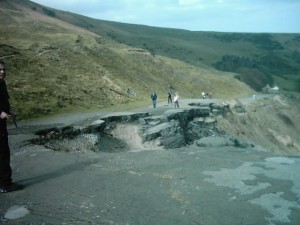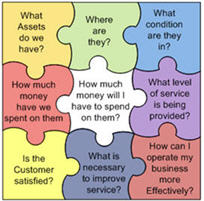Note from the Editor
Hi! Have you seen our new website? We want to know what YOU think!
Speaking of new things, we’re trying something new with YOU, our users…
What's New?
Improved FEMA Functionality!
We already capture the information FEMA needs to reimburse you. Now, we just do it better than ever!
Coming Soon…
Version 8.5! Like the name implies, it’s Version 8… but an UPGRADE – and you don’t have to install a thing…
The Storm Within The Storm
Downed trees and power lines, damaged or destroyed homes and businesses, and flooded sewer systems are the obvious visible signs of a major FEMA event. But the real damage, the “storm within the storm”, is …
21st Century Asset Management Trends
Government organizations are often sleepy, uncompromising bureaucracies that are slow to change. They can fall into doing things “the way we always have” even when it becomes quite clear that doing things the same old way is no longer working…
Note from the Editor
Hi! Have you seen our new website? We want to know what YOU think!
Speaking of new things, we’re trying something new with YOU, our users – an ONLINE User Conference! Many of you have seen and/or used “GoToMeeting” software with us. We’re going to use it to enjoy all the great things about getting together and talking about OUR software – like demonstrations of current and upcoming features, modules, and functionality, brainstorming ideas for new functionality, testimonials from YOU on how you use the software, and more… without the flight delays or lost baggage! Dates and times will be announced soon – we hope YOU can attend!
Also new… Steve! In "Guru’s Corner".
Will you be in the path of the storm? See how CMS can help you recover costs related to a disaster in "What's New" and find out what others have done to be reimbursed in "The Storm Within The Storm".
Did you know? Since our software is constantly being modified and enhanced, we continue to update the integrated HELP file in CMS; just press F1 to get field-specific or topic-specific help. We also periodically post HELP files (as zipped .PDF and .DOCX files) on our website. You can download and unzip either file, onto your machine or onto the server (and create a shortcut to it on your desktop). The Table of Contents is interactive – click on a topic and go right to it! Print selected sections, or the entire user manual! Click here for the Help Document or click here for the Help PDF File.
Enjoy the newsletter, and please continue to let us know what YOU think, feel free to suggest articles, or volunteer for our User Spotlight/Case Study; it’s a great way to showcase YOU, a CMS user – and the unique ways you use it to help you do a better job.
What's New?
New FEMA functionality!
 We already capture the information FEMA needs to reimburse you. Now, we just do it better than ever!
We already capture the information FEMA needs to reimburse you. Now, we just do it better than ever!
You can set up your FEMA events, each with their own set of resource classes, and specify FEMA’s rates! CMS will capture both sets of rates. The true rates are displayed, but FEMA's rates are also captured (in the background) and are available for reports.
FEMA's disaster number can be referenced on the Work Report, and populates your work report entries – AND you can find FEMA work reports easily with our enhanced Advanced Find fields.
Alternate rates!
Ever wanted to capture the true cost of equipment usage, but also need to track a shop rate? Or capture work costs at one rate and BILL at another rate?
 Ever wish you could capture FEMA’s rates without changing every entry to reflect them?
Ever wish you could capture FEMA’s rates without changing every entry to reflect them?
Now you can set up and use Alternate Rates – for labor, equipment, material, and contractor resource entries. The original rate is displayed in the Work Reports, but an alternate rate is captured (in the background) and can be put on your reports – like the Work Report Transaction Detail, Invoice Report, and others.
Coming Soon…
Version 8.5!
Like the name implies, it’s Version 8… but an UPGRADE – and you don’t have to install a thing; it uses the WEBUPDATE procedure you already use.
Although Version 9 will be dynamite, this interim upgrade will provide some really great new features and enhanced functionality. It will be different enough to have a new version number, yet it’s still Version 8!
Guru's Corner
New Guru!
He's part ours, part South Dakota School of Mines & Technology’s…
Stephan has lived all over the Western United States, but recently moved to Rapid City, South Dakota from Maui, Hawaii – in December. Talk about a temperature change!
“Yes, it was quite a change but you can't go wrong with the Black Hills of South Dakota”
He got his Associates degree in Computer Science while working sales and customer service jobs. Stephan is currently working on his Bachelors Degree and working at CitiTech Systems part-time. He takes care of the website and some of the I.T. functions. His current goal is to finish up his Bachelors Degree.
He’s also enjoying the summer. “I like to spend as much time outdoors as I can. This summer I’ve been playing a lot of Frisbee Golf.”
Join us here at CitiTech in welcoming Steve, as he likes to be called!
The Storm Within the Storm
 Downed trees and power lines, damaged or destroyed homes and businesses, and flooded sewer systems are the obvious visible signs of a major FEMA event. But the real damage, the “storm within the storm”, is financial. Local governments rely on the regular income stream from sales tax revenues to fund daily operations- and families rely on regular income from employment to pay their bills and put food on the table. The day after the storm, we awake to find that the economic engine has been shut down – essential services like electricity, water and phone systems are offline, and many business must temporarily close- cutting off both sales tax revenue for local government and income for workers.
Downed trees and power lines, damaged or destroyed homes and businesses, and flooded sewer systems are the obvious visible signs of a major FEMA event. But the real damage, the “storm within the storm”, is financial. Local governments rely on the regular income stream from sales tax revenues to fund daily operations- and families rely on regular income from employment to pay their bills and put food on the table. The day after the storm, we awake to find that the economic engine has been shut down – essential services like electricity, water and phone systems are offline, and many business must temporarily close- cutting off both sales tax revenue for local government and income for workers.
Some agencies have an emergency fund so that they are able to deal with the costs of getting back on their feet quickly. However, they may worry about reimbursement amounts and lengthy waiting periods – so they may try to “spread out” the emergency fund money; pace themselves in terms of recovery activities.
Read More
The first job of government is to “get the lights on”- both literally and figuratively. The sooner services are restored, the sooner the local economy can return to normal. Government cannot “pace itself” in the recovery effort – the longer they delay, the more likely that business may fail permanently, pushing up unemployment and choking the local economy, and extending full recovery from months to years.
 These agencies should realize that although disaster recovery activities are partially reimbursed by FEMA, revenue sources such as sales tax dry up immediately, and that revenue can’t be recovered! Therefore, the faster they can restore services, the faster revenue can begin to flow once again – it’s not just disaster recovery, it’s also revenue restoration. And if they know they can recover their costs relatively quickly, they will feel more comfortable using emergency funds to help get businesses back up and running.
These agencies should realize that although disaster recovery activities are partially reimbursed by FEMA, revenue sources such as sales tax dry up immediately, and that revenue can’t be recovered! Therefore, the faster they can restore services, the faster revenue can begin to flow once again – it’s not just disaster recovery, it’s also revenue restoration. And if they know they can recover their costs relatively quickly, they will feel more comfortable using emergency funds to help get businesses back up and running.
Organizations that use CMS to capture costs related to disasters don’t worry. CMS has proven results in terms of adequate documentation – so they can feel confident using emergency funds to get services up and running, knowing they will be able to recover maximum reimbursement amounts in a timely manner.
The key to complete and prompt FEMA reimbursement is having the ability- before the disaster strikes – to gather all relevant data related to recovery costs from all agency departments. The data must be verifiable, complete, readily accessible and transparent.
One CMS user (Tulsa County Highway Department) has had 3 FEMA events in seven years – and has used CMS to recover maximum reimbursement amounts successfully every time! Twice they submitted CMS reports as documentation, and once they exported CMS information to Excel format. Lesson learned: “If you track your costs with CMS, you will have the information you need for FEMA or anything else that comes along.”
 Another user (City of Spokane Street Department) has had 2 disasters in the last eight years. They tracked the recovery costs with CMS, submitted CMS reports to FEMA as documentation, and were reimbursed for both events.
Another user (City of Spokane Street Department) has had 2 disasters in the last eight years. They tracked the recovery costs with CMS, submitted CMS reports to FEMA as documentation, and were reimbursed for both events.
Clearly, having sufficient documentation to prove claims is key to reimbursement. If up-to-the-minute information can be provided at the touch of a button, organizations can focus on recovery efforts.
21st Century Asset Management Trends
Government organizations are often sleepy, uncompromising bureaucracies that are slow to change. They can fall into doing things “the way we always have” even when it becomes quite clear that doing things the same old way is no longer working. Bureaucracies, often for very good reasons, tend to maintain policies, technologies and management methodologies for decades, until some event forces change. When that change comes, it is often sweeping and systemic. In contrast, the private sector is more nimble than government – they are quick to adopt new technologies and methods that will improve their operations, and as a result, they experience change incrementally.
 For government maintenance organizations, the first major event that forced change came in 1999, when the Government Accounting Standards Board released GASB Statement 34, which mandated that state and local governments report all financial transactions, including the value of their infrastructure assets, roads, bridges, water and sewer facilities, and dams, in their annual financial reports on an accrual accounting basis. Compliance with GASB-34 meant that Public Works agencies across the United States had to change the way they conducted their daily operations. In the past, most cities simply sent crews out to do the work that was required to maintain their assets and tracked costs at the department level. This left them unable to efficiently track maintenance costs, or answer simple questions such as “how much does it cost to fix a pothole?”.
For government maintenance organizations, the first major event that forced change came in 1999, when the Government Accounting Standards Board released GASB Statement 34, which mandated that state and local governments report all financial transactions, including the value of their infrastructure assets, roads, bridges, water and sewer facilities, and dams, in their annual financial reports on an accrual accounting basis. Compliance with GASB-34 meant that Public Works agencies across the United States had to change the way they conducted their daily operations. In the past, most cities simply sent crews out to do the work that was required to maintain their assets and tracked costs at the department level. This left them unable to efficiently track maintenance costs, or answer simple questions such as “how much does it cost to fix a pothole?”.
Read More
Compliance with GASB-34 meant, ideally, that maintenance organizations define and locate their assets so that detailed labor, material, equipment and contractor costs expended to maintain a given asset could be tracked in order to better determine the assets value for depreciation purposes. Cities and counties across the country implemented activity-based costing software applications to better manage work and information, and were able to gain significant insight into cost trends, improve budgeting, and make better management decisions.
State-level agencies (the DOTs) had already been using activity-based costing in maintenance operations for many years when the GASB-34 mandate came out. They moved beyond its basic requirements and adopted TAMS, or the Transportation Asset Management System, as their standard. TAMS is defined as a strategic and systematic process of operating, maintaining, upgrading, and expanding physical assets effectively throughout their lifecycle. It focuses on best business and engineering practices for resource allocation and utilization, with the objective of better decision making based upon quality information and well-defined objectives. TAMS is a performance-based management approach that has largely been ignored at the city and county level.
ISO 55000 will be the next “major event” that forces city and county governments to change.
Globalization created a need for business and government entities to standardize asset management practices. By 2004, The British Standards Institute issued Publically Available Specification 55 (PAS 55) which has since become the defacto international standard. PAS 55 is essentially a guide for the optimized management of physical assets – it provides clear definitions and specifications for establishing and verifying a joined-up, optimized and whole-life management system for all types of physical assets. PAS 55 is proving to be an essential, objective definition of what is required to demonstrate competence, establish improvement priorities and make better, clearer connections between strategic organizational plans and the actual day-to-day work and asset realities. The TAMS model is largely aligned with PAS 55.
 Other standards also exist; for example, the International Infrastructure Management Manual (IIMM) is yet another comprehensive guide that defines asset management as “a plan developed for management of one or more infrastructure assets that combines multi-disciplinary management techniques, including technical and financial, over the lifecycle of the asset in the most cost effective manner to provide a specific level of service”.
Other standards also exist; for example, the International Infrastructure Management Manual (IIMM) is yet another comprehensive guide that defines asset management as “a plan developed for management of one or more infrastructure assets that combines multi-disciplinary management techniques, including technical and financial, over the lifecycle of the asset in the most cost effective manner to provide a specific level of service”.
While TAMS, the IIMM, and PAS 55 are all closely aligned, and all provide guidance for a modern, performance-based asset management approach, the need still exists to clearly define a single standard that will have some teeth. That standard is ISO 55000. It is in the final stages of development with participation from 37 nations and will be published in early 2014.
ISO 55000 will be the next “major event” that forces city and county governments to change. The lengthy economic downturn has put considerable stress on maintenance budgets, and a corresponding degradation of infrastructure asset condition nationwide has followed. The U.S. Congress has already introduced requirements for performance management in the 2012 Transportation bill, and in the recent MAP 21 legislation. The existence of a clearly defined international standard for best practices in asset management will be all the justification that congress needs for further legislation that will mandate clarity and accountability in the maintenance and preservation of our valuable assets.
By Johnny Weisbeck

